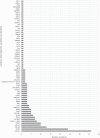Diagnostic utility of next-generation sequencing-based panel testing in 543 patients with suspected skeletal dysplasia
- PMID: 34627339
- PMCID: PMC8501536
- DOI: 10.1186/s13023-021-02025-7
Diagnostic utility of next-generation sequencing-based panel testing in 543 patients with suspected skeletal dysplasia
Erratum in
-
Correction to: Diagnostic utility of next-generation sequencing-based panel testing in 543 patients with suspected skeletal dysplasia.Orphanet J Rare Dis. 2022 Feb 17;17(1):59. doi: 10.1186/s13023-022-02242-8. Orphanet J Rare Dis. 2022. PMID: 35177119 Free PMC article. No abstract available.
Abstract
Background: Skeletal dysplasia is typically diagnosed using a combination of radiographic imaging, clinical examinations, and molecular testing. Identifying a molecular diagnosis for an individual with a skeletal dysplasia can lead to improved clinical care, guide future medical management and treatment, and inform assessment of risk for familial recurrence. The molecular diagnostic utility of multi-gene panel testing using next-generation sequencing (NGS) has not yet been characterized for an unselected population of individuals with suspected skeletal dysplasia. In this study, we retrospectively reviewed patient reports to assess the diagnostic yield, reported variant characteristics, impact of copy number variation, and performance in prenatal diagnostics of panel tests for variants in genes associated with skeletal dysplasia and growth disorders.
Results: Clinical reports of consecutive patients with a clinical indication of suspected skeletal dysplasia who underwent panel testing were examined. The 543 patients included in the study submitted samples for diagnostic genetic testing with an indication of suspected skeletal dysplasia or growth disorder and received one of three nested panel tests. A molecular diagnosis was established in 42.0% of patients (n = 228/543). Diagnostic variants were identified in 71 genes, nearly half of which (n = 35, 49.3%) contributed uniquely to a molecular diagnosis for a single patient in this cohort. Diagnostic yield was significantly higher among fetal samples (58.0%, n = 51/88) than postnatal samples (38.9%, n = 177/455; z = 3.32, p < 0.0009). Diagnostic variants in fetal cases were identified across 18 genes. Thirteen diagnostic CNVs were reported, representing 5.7% of diagnostic findings and ranging in size from 241-bp to whole chromosome aneuploidy. Additionally, 11.4% (36/315) of non-diagnostic patient reports had suspicious variants of unknown significance (VUS), in which additional family studies that provide segregation data and/or functional characterization may result in reclassification to likely pathogenic.
Conclusions: These findings demonstrate the utility of panel testing for individuals with a suspected skeletal dysplasia or growth disorder, with a particularly high diagnostic yield seen in prenatal cases. Pursuing comprehensive panel testing with high-resolution CNV analysis can provide a diagnostic benefit, given the considerable phenotype overlap amongst skeletal dysplasia conditions.
Keywords: Copy number variant analysis; Genetic diagnostics; Molecular diagnostics; Multi-gene panel; Next-generation sequencing; Prenatal genetic testing; Skeletal disorders; Skeletal dysplasia.
© 2021. The Author(s).
Conflict of interest statement
AS, TK, LP, KG, IS, SV, JMK, JT, JS, JK, and T-PA are employees of Blueprint Genetics. MH is a consultant for Blueprint Genetics. The remaining authors declare no competing interests.
Figures
References
Publication types
MeSH terms
LinkOut - more resources
Full Text Sources



